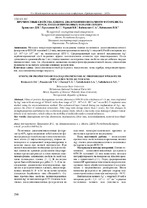| dc.contributor.author | Бринкевич, Д. И. | ru |
| dc.contributor.author | Просолович, В. С. | ru |
| dc.contributor.author | Черный, В. В. | ru |
| dc.contributor.author | Вабищевич, С. А. | ru |
| dc.contributor.author | Вабищевич, Н. В. | ru |
| dc.coverage.spatial | Минск | ru |
| dc.date.accessioned | 2023-12-21T07:32:18Z | |
| dc.date.available | 2023-12-21T07:32:18Z | |
| dc.date.issued | 2023 | |
| dc.identifier.citation | Прочностные свойства пленок диазохинонноволачного фоторезиста ФП9120, имплантированных ионами серебра = Strength properties of diazoquinonenovolac photoresist FP9120 films implanted with silver ions / Д. И. Бринкевич [и др.] // Приборостроение-2023 : материалы 16-й Международной научно-технической конференции, 15-17 ноября 2023 года, Минск, Республика Беларусь / редкол.: О. К. Гусев (пред.) [и др.]. – Минск : БНТУ, 2023. – С. 290-291. | ru |
| dc.identifier.uri | https://rep.bntu.by/handle/data/138533 | |
| dc.description.abstract | Методом микроиндентировния исследованы пленки позитивного диазохинонноволачного фоторезиста ФП9120 толщиной 1,8 мкм, имплантированные ионами Ag+ c энергией 30 кэВ в интервале доз 2,5 1016–1,0 1017 cм–2 на имплантаторе ИЛУ-3. Сформированный при ионной имплантации Ag+ карбонизированный слой подавляет эффект восстановления отпечатка при индентировании. После длительного хранения (более 3 лет) пленка изменяет свои прочностные свойства и ведет себя как твердое (непластичное) тело, что обусловлено сшиванием молекул фенолформальдегидной смолы, снижающим подвижность молекул в условиях внешнего воздействия. | ru |
| dc.language.iso | ru | ru |
| dc.publisher | БНТУ | ru |
| dc.title | Прочностные свойства пленок диазохинонноволачного фоторезиста ФП9120, имплантированных ионами серебра | ru |
| dc.title.alternative | Strength properties of diazoquinonenovolac photoresist FP9120 films implanted with silver ions | ru |
| dc.type | Working Paper | ru |
| local.description.annotation | Films of positive diazoquinone novolac photoresist FP9120 with a thickness of 1.8 μm, were implanted by Ag+ ions with an energy of 30 keV in the dose range of 2.5 · 1016–1.0 · 1017 cm–2 on an ILU-3 implanter were studied using the microindentation method. The carbonized layer formed during ion implantation of Ag+ suppresses the effect of indentation restoration. After long-term storage (more than 3 years), the film changes its strength properties and behaves like a solid (non-plastic) body, which is due to the cross-linking of phenol-formaldehyde resin molecules, which reduces the mobility of molecules under external influences. | ru |

